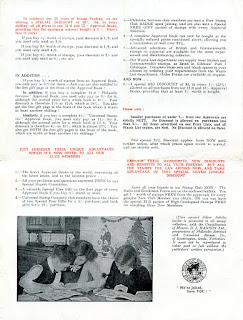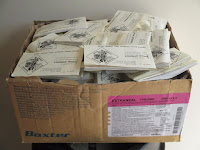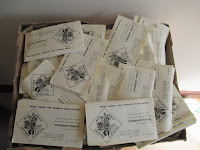“Can I look?” he asked, and without waiting for an answer reached
down and slid the white lamp upwards from its bracket in front of the handlebars. “A really
good lamp,” he smiled, examining it closely and seeing how far it could
shine, “and a new one too.”
I smiled back gullibly. He glanced around furtively and then ran off along the street, lamp in hand, the beam moving up and down on the wall with the movement of his arm. I watched in disbelief as he disappeared around a corner, and started to cry loudly. My mother came running out of the house and took quite a time to calm me down. I had just been introduced to the world’s wickedness, a crime victim at the age of four. We never saw the lamp again.
“Would you recognize him if you saw him?” she asked. I didn’t know what ‘recognize’ meant.
In the flat streets where I grew up, the roads belonged to bicycles. Everyone had one, and nearly everyone used them, at least some of the time, as their main everyday transport. Four times a day, when the women rode to and from the clothing factory, or the children to and from the schools, or the men to and from the railways, docks and shipyard, they packed the roads three and four abreast - four times a day because most people went home for their ‘dinner’. With no room to overtake, motor vehicles, the few there were, had to crawl along at bicycle speed. When the railway gates closed, cars, vans, lorries, buses, and even motor cycles had to wait patiently behind as many as forty or fifty cyclists who had zig-zagged through to the front of the queue. Who needed a motor vehicle when you could cycle everywhere effortlessly on level roads? Even when it was raining a bicycle cape kept you dry, a shaped waterproof sheet draped over your arms, back and shoulders down to the pedals, with just a hole for your head. Better to be an unfashionable yellow rhinoceros than a soggy wet dog.
My three wheeler came at the start of my bicycling years after graduating from pedal cars. I rode along the pavement at the front of the house, bumping rhythmically over the slabs like a train on a railway track, and returned round the back, past the bomb-buildings, along the smooth concrete surface of the back lane where once a rag and bone man’s horse deposited a stinking pile of manure that kept me away for a couple of weeks until it dried and turned white.
They resurfaced the road at the front, and the loose chippings drifted down the camber to collect in the gutters. I gathered them up in a little tray fixed to the back of my bike, and took them to my mother’s uncle who mixed them with cement to make himself a new front door step. He glanced furtively up and down the street before lifting them inside, the same look as the boy who had stolen my lamp, receiving stolen road stone from a four year old thief. That step is still there after sixty years, as good as the day he built it.
For safety, I ‘helped’ my dad paint white panels on the rear mudguards, just as legally required then on grown up bikes. But my first accident was due to lack of experience rather than lack of visibility. I thought I could reverse my tricycle square against the high wall of the lane and lean back comfortably against it, but the tricycle rolled forwards and I fell backwards cracking my head on the concrete. More crying. My mother came running out of the house horrified by the red pool of blood collecting on the ground. Perhaps a helmet would have saved me, but even if they had been invented then they certainly had not yet been declared ‘essential’ by the health and safety squad.
I moved excitedly up to a two wheeler at around seven or eight, a second hand one. My mother puffed up and down the road behind supporting the saddle, struggling to keep up, and then, in an instant, she was no longer with me, and with a surge of elation I knew I could do it. A year or so later, my dad took me to the cycle shop to order a spanking new bike. That was a good business to be in; there were around half a dozen bicycle sales and repair shops in the town.
My new bike was bigger and fabulously modern, a Raleigh of course. I chose one with the latest straight handlebars rather than the traditional backwards-pointing ones, white mudguards, calliper brakes rather than rods, a front wheel dynamo for the lights, and a three-speed Sturmey Archer rear hub, much simpler to operate than the derailleur gears on racing bikes. You didn’t really need gears on our flat streets except to accelerate quickly and go faster.
Apart from the usual minor scrapes and grazes I only remember falling off properly on two occasions. The first time, not long after learning to ride, I hit a large stone while following my dad along the river back. My bike stopped dead throwing me forwards over the handlebars, landing on my back in soft grass after a perfect mid-air somersault. I got on my bike again and caught up my dad who had no idea I hadn’t been behind him all the time. The second time was more serious. I stood on the pedals to accelerate, the gear slipped, the pedal gave way and I dropped painfully down on to the crossbar and lost control. I was still moving forwards when my face hit the road, scraping off a strip of skin from chin to forehead, lucky not to break my nose. I looked quite a sight for the next couple of weeks.
No one ever expressed any concerns about young children riding around the streets and lanes on tricycles, or older children around town on two wheelers, nor when we went on longer rides in the school holidays. Around ten miles away was Skipwith Common, the location of R.A.F. Riccall, an abandoned wartime airfield where crews were trained to fly Halifax bombers. Nature was already beginning to reclaim the buildings and runways, and it was a great place to explore. It remains a diverse natural habitat today.
Slightly further was Selby, where the London to Edinburgh railway line crossed the Ouse at the northern end of the station platform, and every train, no matter how important, had to slow down to rattle across the swing bridge at forty miles an hour. A constant procession of powerful main line steam engines with evocative names passed through all day in both directions, enabling me to cross off now long forgotten A4 ‘streaks’ such as ‘Silver King’, A1 Pacifics such as ‘Bongrace’, Britannias such as ‘Rudyard Kipling’, and some of the new English Electric diesels. It was a trainspotters’ paradise.
Skipwith and Selby always seemed much further away on the way home. Around half-way back was a playground in a grassy field, which always provided a much needed rest. If you saw that road now, with its stream of fast cars and heavy lorries, you would be appalled at the idea of eleven and twelve year-olds riding off for the day.
Most of us were thus thoroughly accustomed to busy traffic long before it was decided we needed to take our cycling proficiency tests.* We practised in the army drill hall with long strips of canvas rolled out to represent roads and junctions. I put my new knowledge into use straight away, waiting at the crown of a road to turn right from a minor road into a major road. Unfortunately, it was at the same moment a large lorry wanted to turn right into the road where I was waiting. “The lorry has priority” I told myself confidently, so continued to wait at the crown of the road. The driver wound down his window and told me in no uncertain terms to “get out of the bloody way”. So much for the theory.
As for the practice of being able to control our machines, I suspect we could have taught the instructor a few things. Riding slowly and weaving between cones was simple. We could have shown him the finer skills of carrying two people on one bike and how to look cool while riding along nonchalantly with hands in pockets. Two of my schoolmates could even swap bicycles while riding along without either of them getting off or stopping.
We passed our tests one mild Saturday afternoon in April on the deserted roads of the industrial estate. I proudly received my badge and certificate and quietly went back to my old streetwise ways. But I always maintain that our road-wise experience and natural understanding of things like gears, momentum, acceleration, braking and centrifugal force, gave us a head start when it was time to learn to drive.
In due course my ‘new’ bicycle really became too small for me, but it stayed with me for many years. It saw me through six years in Hull, another pancake flat place. Once when I’d chained it to a bike rack, I returned to find someone had helped themselves to the Sturmey Archer back wheel and had to walk home. I thought of my stolen front lamp from an earlier time. The wheel and hub were surprisingly inexpensive to replace; it always amazes me how cheap bicycle parts are in comparison with car parts of similar complexity.
Not so long ago I took my family to see the place I grew up. At the motorway exit roundabout we stopped to wait for a large middle aged man on a bicycle labouring slowly against the rain and wind, oblivious to the queuing traffic. He was wearing a flat cap and a brown gabardine mackintosh belted over a blue boiler suit, his baggy trouser legs secured at the ankles by bicycle clips. It could have been my dad from sixty years ago. My children laughed out loud at this solitary remnant of the droves of cyclists who used to block the roads four abreast.
“It’s Fungus the Bogeyman,” they shrieked.
“You are now entering my home town,” was all I could think to say.
* Andrew Petcher's Age of Innocence blog has similar recollections of the cycling proficiency test.



















